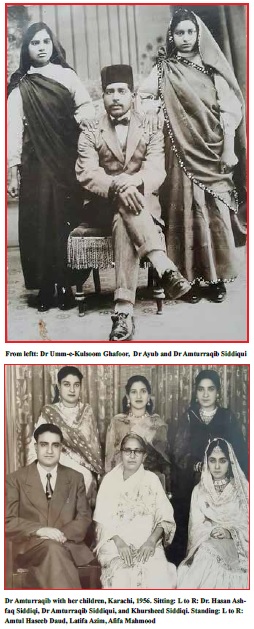The Yaqoob Sisters: First Female Muslim Medical Doctors of Indo-Pak Subcontinent
By Khalid R. Siddiqui, MD, FACRO

This article is the story of Drs Amturraqib Siddiqui and Umm-e-Kulsoom Ghafoor. Dr Amturraqib Siddiqui is my father’s chachi or, in other words, my dada’s bhabi. I met her in 1961 in Pishin, near Quetta, in Balochistan. The article was written by her grandson Prof. Dr Najam Ashfaq Siddiqi and his wife, Shehla Najam Siddiqi. My contribution is restricted to some modifications in the original article.
Dr Amturraqib Siddiqui and Dr. Umm-e-Kulsoom Ghafoor
By Prof. Dr Najam Ashfaq Siddiqi & Mrs Shehla Najam Siddiqi
Their father’s name was Mohammad Yaqoob who was born in 1867 as Ganeshi Lal to a rich and affluent Hindu merchant-class Agarwal family of Nagina (presently in Haryana State), near Delhi. Ganeshi Lal’s father’s name was Girdhari Lal, and he was his only child and the heir to all his wealth. In his early teens Ganeshi Lal got inspired by his Arabic teacher (those days Hindus too used to learn Arabic and Persian), and converted to Islam, thus becoming Mohammad Yaqoob. He abandoned his luxurious lifestyle, and after considerable struggle in life became the headmaster of a government school at Bilaspur in the Ambala District of present day Haryana.

Mr and Mrs Yaqoob were broad-minded and believed in modern education. So, despite all his monetary limitations and, at the same time, criticism from his newly adopted Muslim community Mr Yaqoob gave modern education to all of his eight children. Two of their daughters (Amturraqib and Umm-e-Kulsooom) got medical education, thus receiving the honor of becoming the first Muslim female medical doctors of the Indo-Pak subcontinent.
Medical education in those days was given in the mixed classes at men’s colleges. Indian women in general and Muslim women in particular were not allowed to study in co-education medical schools.1 So, to encourage the women of Subcontinent to study medicine, the British government established three medical schools exclusively for women – in Agra, Calcutta and Madras. Mr Yaqoob allowed the two daughters to take admission in the Agra Medical School in 1916. Although Umm-e-Kulsoom was two years older, the two sisters started medical school in the same year. In that era, it was rare for the Muslim women to get formal education, and getting any professional education was simply unthinkable.
The Yaqoob sisters earned their Licensed Medical Practitioner (LMP) diploma, the only authentic medical practicing diploma/degree given at that time, from the Agra Women Medical School in 1920.1, 2 LMP was later replaced by LSMF (Licentiate of State Medical Faculty), and then by MBBS in Indo-Pak subcontinent.2
Dr Amturraqib Siddiqui
Dr Amturraqib Siddiqui was born in Mullana, District Ambala, Indo-Pak subcontinent on February 22, 1900. She got schooling at St. John’s Girls High School, Agra. She graduated from Agra Women Medical School [presently Sarojini Naidu Medical College (SNMC)], in 1920.3 She graduated on 9th October 1920 along with her sister Umm-e-Kulsoom, thus becoming one of the first two Muslim women Licensed Medical Practitioners (LMP). The same year she got married to Dr Ishaq Siddiqui Nashit.4 They had one son and three daughters - Professor Dr Hasan Ashfaq Siddiqi, Amtul Haseeb Daud, Afifa Mahmood and Latifa Azim.5 Before Partition, she practiced medicine in Bareilly and Aligarh, UP. After the creation of Pakistan, she moved to Karachi and worked at the Kharadar Maternity Hospital as the Resident Medical Officer. She passed away on July 7, 1971 in Quetta, Pakistan. Her son, Professor Dr Hasan Ashfaq Siddiqi, graduated from King Edward Medical College, Lahore. He worked for the Government of Balochistan - first as Professor of Community Medicine and Public Health, and later as Principal of Bolan Medical College which was associated with the Balochistan University.
Dr Umm-e-Kulsoom Ghafoor
She had a long and active medical, political, social and academic career. She and her husband, Dr Abdul Ghafoor Bismil, became successful medical practitioners in Pilibhit, UP, Indo-Pak subcontinent. In recognition of her services in the medical field she was made a Member of the State Board of Medical Faculty, United Provinces, Indo-Pak Subcontinent.6 She was also an activist of the Pakistan Movement. She was the President of All-India Muslim League (Women wing), Pilibhit District, UP.6
Due to her great services to the women of India in the medical field, the then government of UP awarded her an honorary degree of “Fellow of State Medical Faculty” (FSMF).6 She was also a member of the Pilibhit Municipal Board for 18 years.6 Her scholarly activities include a book “Ruedad-e-Qafas”. She was also the editor of magazine “Harem” published from Pilibhit from 1927 to 1930.6 Drs Umm-e-Kulsoom and Abdul Ghafoor Bismil migrated to Pakistan and settled in Larkana, Pakistan, and became the family physicians of Sir Shahnawaz Bhutto.6
References
1. Mathur NN. Indian Medical Colleges. The National Medical Journal of India. 1998, 11:97-100
2. Roll of the Indian Medical Services 1615-1930. Vol. 1 written by Lieutenant Colonel D.G. Crawford, Chapter XLIII: Medical Education in India. Naval and Military Press Ltd, UK
3. http://www.snmcagra.in/history.html
4. Book entitled “Nida-e-Nashit” written by Dr Hasan Ashfaq Siddiqi, March 2000, Word Mate, Islamabad, p. 31
5. Book entitled “Nida-e-Nashit” written by Dr Hasan Ashfaq Siddiqi, March 2000, Word Mate, Islamabad, pp. 10-11
6. Book entitled “Ruedad-e-Qafas” written by Dr Mohammad Abdul Ghafoor Bismil and Dr Umm-e-Kulsoom Ghafoor. 1952, All Pakistan Educational Conference, Sind Madrasa, Karachi, p. 5.
7. Book entitled “Nida-e-Nashit” written by Dr Hasan Ashfaq Siddiqi, March 2000, Word Mate, Islamabad, p. 33
-----------------------------------------------------------------------------
Back to Pakistanlink Homepage

